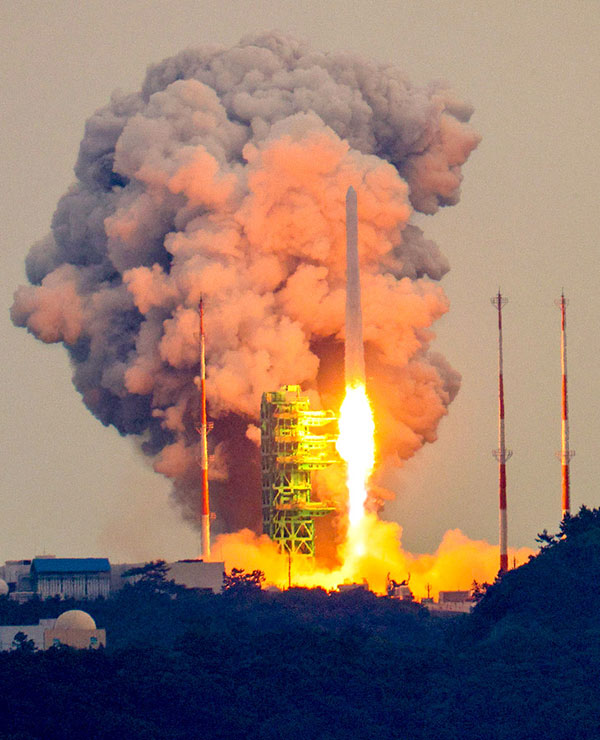TRI VAN (Synthesis)
South Korea launched its domestically-built Nuri rocket on May 25 to put eight experimental satellites into orbit. The launch is seen as an important step forward for the country's ambitious space program.
Nuri rocket leaves launch pad on May 25. Photo: Reuters
The Ministry of Science , ICT and the Korea Aerospace Research Institute (KARI) said the Nuri rocket was launched from the Naro Space Center in Goheung Village at 6:24 p.m. (local time). After taking off and completing a flight of about 20 minutes, the rocket put the satellites into orbit 550km above Earth in about 13 minutes.
Yonhap news agency reported that the Nuri rocket is 47.2 meters long, 3.5 meters in diameter and weighs 17.5 tons. Unlike the first and second launches that only carried simulation satellites, the Nuri rocket in this third launch carried eight experimental satellites that can perform actual missions, including a commercial-grade satellite tasked with verifying radar imaging technology and observing cosmic radiation in near-Earth orbit.
“Today, we have confirmed that the dream can come true. I hope our future generations will have a big dream and challenge to see the Nuri rocket soaring into space,” South Korean President Yoon Suk-yeol wrote on his Facebook page. “We can have foreign customers in the near future and send their satellites into space like other space powers such as the United States,” said Kwon Se-jin, a professor at the department of aerospace engineering at the Korea Advanced Institute of Science and Technology (KAIST).
The successful launch of the Nuri rocket has boosted South Korea’s hopes of catching up with Asian neighbors China, Japan and India in the regional space race. Experts say the launch will also help South Korea accumulate technology and operate military spy satellites and build long-range missiles. South Korea currently has missiles capable of reaching North Korea. But experts say Seoul needs longer-range missiles to prepare for future security threats from potential rivals such as China and Russia.
After many failures over more than two decades, South Korea launched the Nuri project, also known as KSLV-II, investing nearly 2 trillion won (equivalent to 1.52 billion USD) to build a three-stage rocket using domestic space technology, from design, manufacturing to testing and launch. In 2021, the Nuri rocket successfully flew to a target altitude of 700 km but was unable to put a dummy satellite into orbit because the rocket's third-stage engine started up earlier than expected. In 2022, the Nuri rocket completed its mission of putting the dummy satellite into the target orbit as planned, helping South Korea become the 7th country in the world to develop a space launch vehicle that can carry a satellite weighing more than 1 ton, after Russia, the US, France, China, Japan and India.
In addition to the rocket launch, South Korea has outlined ambitious plans for its space program. Accordingly, Seoul plans to conduct three more Nuri rocket launches by 2027 in an effort to upgrade the country's space rocket program. In addition, the South Korean government also plans to launch the KSLV-III space project, developing a next-generation rocket with a total investment of 2.1 trillion won over the next 10 years. The project aims to develop a two-stage rocket using multi-stage combustion technology to send a Korean-made lunar lander to the Earth's satellite by 2032.
Notably, after the successful launch of the Nuri rocket in 2022, South Korea announced a roadmap for its “future space economy”, making the country a “space economy” power. Accordingly, the South Korean government will establish an aerospace agency similar to the US National Aeronautics and Space Administration (NASA).
Inter-Korean spy satellite race For its part, missile tests since 2022 have shown that North Korea has the ability to launch nuclear strikes against South Korea, Japan and the US mainland, and is seeking to develop more sophisticated weapons systems. Leader Kim Jong-un boasted last month that Pyongyang had completed its first military reconnaissance satellite and called for it to be launched into orbit to monitor US and allied forces in Asia. South Korea is also developing a spy satellite under the Agency for Defense Development, spending more than $1.1 billion by 2030. The first South Korean military spy satellite is expected to be launched in November on a SpaceX Falcon 9 rocket. Currently, South Korea relies on the US satellite system to monitor North Korea's military activities, and Seoul's goal is to launch and own its own spy satellite system. |
Source link





































































































Comment (0)